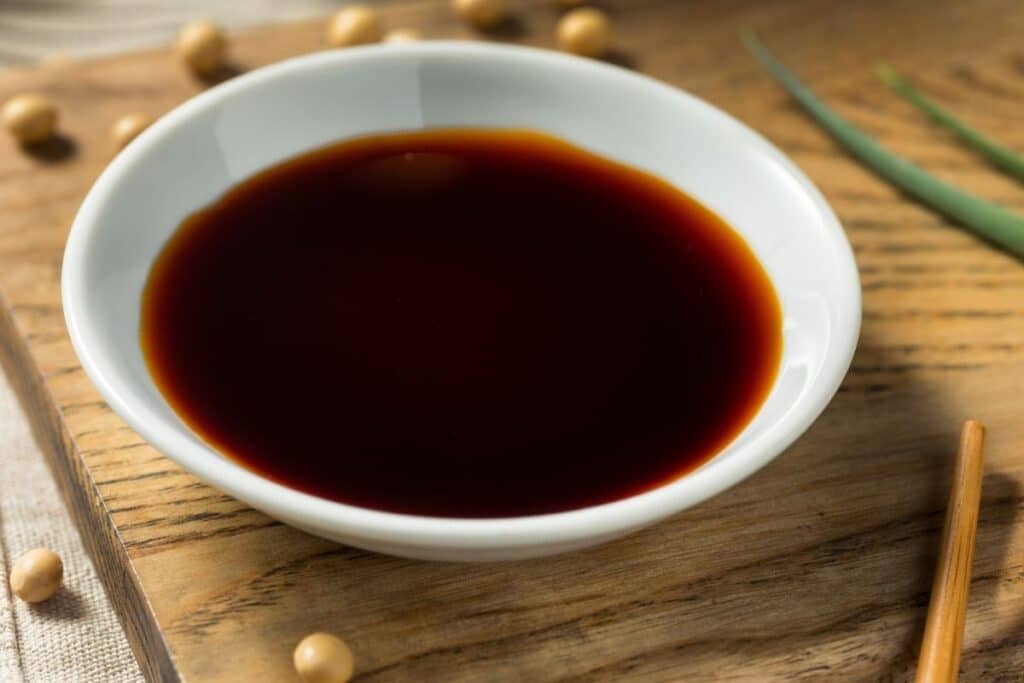In summary: Alternatives to coconut aminos include low-sodium soy sauce, tamari, liquid aminos, Worcestershire sauce, fish sauce, etc. Consider dietary needs and flavor profiles when choosing a substitute.
Despite its name, coconut aminos does not taste like coconut. So, if you’re looking for a coconut-flavored substitute, you’re making a mistake. Rather, this dark-colored sauce is very similar to light or low-sodium soy sauce with a tinge of sweetness.
If your recipe calls for coconut aminos and you have no idea where to find it, or have little interest in buying an entire bottle for one recipe’s use, there are a range of substitutes that are much easier to find, and probably already in your kitchen. This is your guide to the best coconut aminos substitutes.
What is Coconut Aminos?
This dark seasoning sauce is made from coconut blossom nectar (or coconut tree sap) which is fermented and seasoned with salt. Since it is not made from the coconuts themselves, it does not have a coconutty taste.
It has a slightly sweet undertone and is an ideal seasoning sauce for people who need to avoid soy, wheat, or gluten in their diets. If you love cooking with soy sauce but need to avoid these ingredients, coconut aminos is a good alternative to soy sauce. You can purchase this sauce online or find it at a health food store. Large, well-stocked supermarkets often keep it too.
Coconut aminos is used in recipes for savory flavor, including marinades, dressing, sauces, broth, stew, stir fry, dips, and rice dishes.
Best Replacement for Coconut Aminos You Can Use
1. Soy Sauce
The best and closest substitute is what you likely know as soy sauce, or Chinese shoyu sauce. It is made from soybeans that are soaked and cooked, after which the paste is mixed with wheat, brine, and a fermenting culture called kōji.
This salty brown sauce traditionally takes months to produce. After fermentation, it is pressed to drain the liquid which is pasteurized, bottled, and packaged as soy sauce.
To replace coconut aminos you may want to go for the low-sodium soy variety since regular soy sauce has a higher salt content. If you use the low-sodium type, replace it in equal quantities. If you have regular or traditional soy sauce in the pantry, start with half the amount required and add to taste to prevent over-salting the dish.
If you are allergic to soy, wheat, gluten, or need to eliminate salt from your diet, soy sauce is not the best option for you.
Best for: Marinades, sauces, dipping, sautes, eggs dishes, rice dishes, broths, dressings, and stir fry.
Related: Substitute for soy sauce
2. Tamari
If you are wheat or gluten intolerant, tamari is the next best coconut aminos alternative since it does not contain either of those ingredients. It is, however, made from fermented soybeans in a similar fashion to soy sauce. Although it does not contain wheat, always check the label of the brand you are buying to be sure. It may just be processed in a facility that also handles gluten products, causing trace amounts to be present in the sauce.
Tamari can be replaced in equal quantities as the salty flavor is not overpowering. It will bring a similar coconut aminos taste, depth, and color to your dish. If you are watching your salt intake for health reasons, you will still want to be careful with the amount you use in general.
Best for: Marinades, dipping, sautes, eggs dishes, rice dishes, broths, dressings, and stir fry.
See more: Tamari substitute
3. Liquid Aminos
Liquid aminos is a salty, gluten-free liquid protein concentrate with a slightly sweet flavor which makes it an ideal swap in equal quantities. It is made from unfermented soybeans. Although the names are similar, it is not the same as coconut aminos since the coconut sap version does not contain any soy.
Best for: Noodle and rice dishes, stir fry, marinades, broths, dressings, and any other recipes that require a replacement.
4. Worcestershire Sauce
Worcestershire sauce has its origins in Britain and is a great lower-sodium option. It is dark in color and has a thin consistency. Although less salty, it has a fairly pronounced vinegar flavor and adds great umami depth to soups and stews.
The sauce is made from a blend of vinegar, anchovies, spices, sugar, salt, tamarind extract, garlic, onions, and molasses. It does contain anchovies, but does not taste fishy.
Most brands are soy- and gluten-free but it is always advisable to double-check the label. The production process may include shellfish, so best to avoid Worcestershire sauce if you have shellfish or seafood allergies.
Use this as a coconut aminos substitute in equal quantities
Best for: Recipes that require a replacement for added flavor but not necessarily saltiness. It is ideal for meat marinades, stews, sauces, and broth.
Related: Replacement for worcestershire sauce
5. Fish Sauce
We’ve covered the most similar tasting substitutes, however, if you don’t have any of those on hand, there are a few more to consider. Fish sauce brings loads of flavor but can be powerful, so start with a small amount and add to taste. As its name suggests, it is made from salt fermented fish or krill, so won’t be the right choice if you have seafood allergies.
Best for: Stews, broth, marinades.
See more: Fish sauce substitute
6. Miso Paste
Miso is made in a similar way to soy sauce. The thick paste is a combination of fermented soybeans, salt, and kōji. Some varieties also include barley or rice in the production process. Miso paste is very salty and shouldn’t be used as a paste but rather diluted in water or liquid for the added depth of flavor.
To use it, mix a small amount with water and stir to dissolve the paste evenly (you don’t want to bite into a chunk of undissolved miso). Add the thinned paste to the other ingredients and mix through. Taste the full profile with other ingredients before adding more to prevent overpowering the dish.
Although the consistency isn’t the same, it will bring a similar depth of flavor. Mix 1 part miso with 1 part water to make up an equal quantity of coconut aminos. Therefore, if your recipe calls for two tablespoons of coconut aminos, mix one tablespoon miso with one tablespoon water as a replacement. You can even start with slightly less miso and add to taste, especially if you are watching your salt intake.
Best for: Soups and stews.
7. Dried Mushrooms
Here, you don’t specifically want to use the mushrooms as your substitute, but rather their rehydrating liquid. Dried shiitake mushrooms are a great natural, vegan, and healthy ingredient without the salt, gluten, or soy. This option won’t offer the same intensity as many of the other options, however, it does bring a unique depth of flavor that can be amped up with a pinch of salt or spice.
When using dried shiitake mushrooms in a stir fry, rehydrate and soak them in a small amount of boiling water to extract the flavor. Then use the soaking liquid in your dish. When cooking a soup or stew, you can cook the mushrooms in the liquid with the other ingredients to impart flavor.
Best used in: Soups, stews, and recipes that require a mild flavor addition.
See more: How to dehydrate mushrooms
8. Maggi Sauce
Maggi sauce is a dark-colored Swiss condiment made from fermented wheat proteins. It is salty and somewhat reminiscent of vegemite in a liquid form. Use only half the amount required to avoid overpowering the dish.
Best used in: Marinades, sauces, sautes, eggs dishes, rice or noodle dishes, broth, stew, and stir fry.
9. Homemade Coconut Aminos
A great option, especially if you want to control the salt level and ingredients for allergy reasons, is to make your own homemade version. In this case, you can use gluten-free or low-sodium ingredients to custom make the sauce to suit your needs.
Ingredients
- 2 tablespoons regular or low-sodium beef broth or bouillon
- 1 teaspoon dark molasses or maple syrup
- 2 teaspoons balsamic vinegar
- Pinch of garlic powder
- Freshly ground black pepper, to taste
Directions
- Combine the ingredients
- Combine the beef broth, molasses, vinegar, and garlic powder with ¾ cup of water in a small saucepan.
- Simmer and reduce
- Let the mixture just boil and then turn down the heat. Simmer until the liquid reaches your preferred flavor strength and consistency. This should take around 10 minutes.
- Season. Add salt and pepper to taste.
FAQ
The flavor and consistency are somewhat different, however, mixing a little soy with the teriyaki will give you a sweet and salty umami flavor that will add a whole lot of deliciousness to your dish. It is especially great in stir fry, as a marinade, or a dipping sauce, but won’t work well for salad dressings.
Yes, once you have opened the condiment, it is best stored in the refrigerator.
Stored in the refrigerator, the sauce will last around 6 months at its best quality.
A suitable substitute for 1/4 cup of coconut aminos could be 3 tablespoons of soy sauce or tamari combined with 1 tablespoon of water, to achieve a similar flavor profile in your recipe.
Conclusion
Not quite a pantry staple, coconut aminos is great for seasoning savory dishes, marinating meats, seasoning vegetables, stir fry, and much more. There are a variety of alternatives which you are more likely to have around, so don’t ditch the recipe just because you don’t have any on hand.
If you are cutting back on salt, avoid miso, regular soy, and Maggi sauce as alternatives. Good soy-free options are Worcestershire sauce and dried mushrooms.
Whichever option you choose, these ingredients all pack a delicious punch of flavor, so that is one thing you won’t be short on.
*image by bhofack2/depositphotos









